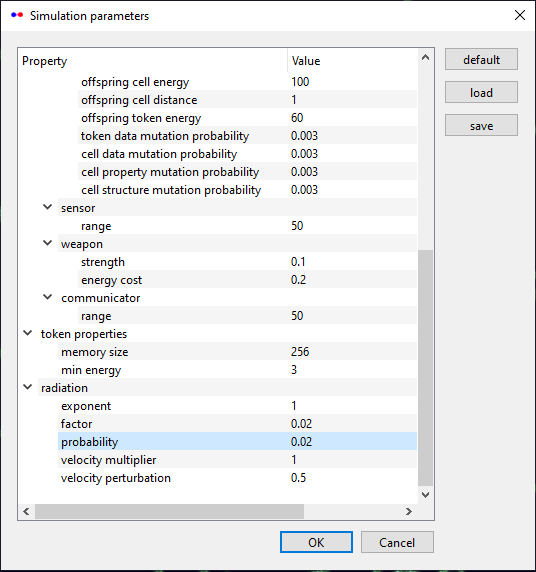Exploring the life cycle of cells and particles
Abstract
In alien, cells and energy particles can emerge, collapse and connect (in the case of cells) or unite (in the case of energy particles) in different ways. These processes can be controlled by various parameters and lead to a certain equilibrium after some time. We want to explore these processes in more detail. A particularity are the cell functions that can break these equilibria, but this will be addressed in later tutorials. Here, we will perform small experiments by changing various simulation parameters that are responsible for the life cycle of the cells
What you will see
1. Simulation with high radiation
The first experiment is designed to familiarize with the radiation of energy particles from cells. Cells as well as tokens have internal energy. The internal energy ensures their stability and provides the capability to perform actions via cell functions. The following transformation processes are significant in this regard:
- A cell emits radiation in the form of energy particles. Both the frequency and the intensity of the radiation can be adjusted via parameters. Due to the emission, cells and tokens lose internal energy over time.
- The reverse case is also possible, namely that a cell absorbs other energy particles when it collides with it. In this case, the value of the internal energy increases.
- If the internal energy of a cell falls below a critical value, the cell itself decays into an energy particle containing the residual energy.
- If two energy particles collide, they unite to form a single particle which has the sum of both energies. If this energy exceeds a critical value, a new cell is formed.
For our experiment we want to significantly increase the radiation in both intensity and frequency. This will lead to a fast destruction of the matter. To proceed, we load the simulation file
./examples/simulations/replicator - ecosystem.sim.
Since we are now setting a high radiation, decay and thus the emergence of many small cell clusters will occur. For this reason we adjust the CUDA parameters by increasing the maximum number of clusters in the General settings dialog to 300,000. Next, we open the Simulation parameters dialog and set the following parameters:
- We set radiation → probability to 0.02: This parameter indicates the probability (value between 0 and 1) with which a cell will emit an energy particle in the next time step.
- We set radiation → factor to 0.02: This value corresponds to the intensity of the radiation. The average amout of radiated energy per time step and per cell calculates as β * c^α, where c denotes the internal energy of the cell, α is the radiation exponent (a further parameter set to 1 by default), and β is the radiation factor. The radiated energy is independent of the radiation probability. For example, if a high radiation probability is set, many energy particles with low energy will be emitted. If the radiation probability is low, few but very energetic energy particles will be emitted.

Create a snapshot and start the simulation. You will see how fast the matter decays at the high radiation. In addition, many smaller cell clusters are formed due to the unifications of energy particles, which in turn can transform into cells if their energy is high enough.

Above we see the result in 4x and below in 1x zoom.

2. Simulation with many fusion processes
In the second experiment we want to investigate the fusion of cell clusters. To this end, we return to the initial state (restore snapshot) and open the dialog for simulation parameters again. We will set the parameters so that cell clusters will merge particularly frequently. In general, when two clusters are approaching each other and the velocity exceeds a critical value, a fusion can occur, provided that the colliding cells can still form new bonds. After fusion, the common cell cluster may have lower kinetic energy. The energy difference is spent in the generation of tokens that are created at the fused cells. We will discuss tokens in more detail in later tutorials.
We continue by resetting the radiation → factor and radiation → probability to 0. Then, we lower the critical fusion velocity (under cell properties) to 0.04. After starting the simulation, we see how many cell clusters merge after collisions. Since no radiation was activated, they do not decay anymore.

In the screenshot above you can see the formation of large cell clusters due to fusions.
3. Simulation with many damage processes
As a final experiment in this tutorial, we will change the strength of matter. For this purpose there exists the parameter max force under cell properties. As soon as a force acts on a cell (e.g., due to rotation of the cluster or sudden changes in velocity after collisions) that exceeds this parameter, the cell decays into an energy particle with a certain probability. To perform our experiment, we return to the initial state and adjust the simulation parameters. Please note that when restoring snapshots, the simulation parameters are left as they are. For this reason we reset the fusion velocity to 0.4 and decrease the max force to 0.04 instead. The stability is now so low that all cell clusters break immediately after the slightest shocks.

It is important to note that although various energy conversion processes occur between the internal energies and the kinetic energies, in all of the above processes (radiation, collisions, damage, and fusions of energy particles and cell clusters), conservation of energy is satisfied.
Created with the Personal Edition of HelpNDoc: Easily create Qt Help files